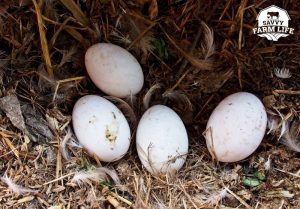
Duck Egg-Laying Schedule
While not as popular as chickens, many farmers prefer duck eggs over chicken eggs because of their taste, size, and nutritional differences. If you are considering raising ducks, you are likely wondering about egg production and laying habits. At what age do ducks start laying? How often do ducks lay eggs? Are they year-round or seasonal layers?
When do ducks lay eggs? Egg production and laying seasons vary according to a duck’s breed, with the most prolific layers producing upward of 300 eggs per year. Most ducks begin laying eggs between 5 and 7 months of age, with egg production diminishing every year until it stops completely around 7 to 9 years of age.
Ducks are a great alternative to chickens as they lay just about as frequently and regularly as chickens. However, they do have some differences. If you want to raise ducks for egg production, keep reading to get a complete rundown about ducks laying eggs!
At What Age Do Ducks Begin Laying Eggs?
If you are considering raising ducks for eggs, you will likely be purchasing ducklings at a feed store or from a local farmer. The ducklings you purchase will probably be only a few days old when you bring them home, and as you are going through your brooding adventure you will be eagerly awaiting your first duck eggs. How long will you have to wait? Most breeds of ducks begin laying between the ages of 5 and 7 months, but some may start laying as early as 4 months. There are not any tell-tale signs that your ducks are approaching sexual maturity, so you will just have to settle on being surprised!
Ducks, like chickens, will be most productive during their first year of laying. They will lay fewer eggs annually after that, until they stop completely at around 7 to 9 years of age. The life expectancy of a duck is between 8 and 12 years.
Are Ducks Seasonal Layers?
Whether ducks are seasonal or year-round layers will depend on the breed of duck you are raising. While even seasonal layers can be duped into laying year-round through the use of artificial lighting in the Winter months, some breeds like the Indian Runners will lay year-round with no supplemental light needed.
Seasonal layers will ramp up their egg production beginning in the Spring and going strong into the Summer, with laying slowing down in the Fall. Most duck breeds will stop laying in the Winter if left to their natural breeding cycles.
What Time Of Day Do Ducks Lay Eggs?
Most ducks will lay their eggs in the early morning hours – usually between 4 am and 8 am. This is a helpful fact to know as a duck farmer, because ducks are notorious for laying their eggs wherever they please.
If you are familiar with the habits of chickens, you know that you can usually find the eggs tucked safely in the nesting boxes that you created for that very purpose. Collecting eggs is one of the favorite chores of a chicken keeper – you grab your basket and head to the coop, raise the nesting box lid, and are greeted with a nest full of eggs.
If that all sounds lovely, forget about it if you are considering raising ducks. You might provide the perfect nesting boxes for your ducks, and they will likely ignore them. If your ducks free-range and you don’t have a duck house in which they spend the night, you will find yourself on an egg-hunting adventure every day. Of course, this can still be considered a fun chore – who doesn’t love hunting for eggs? But it does mean that collecting duck eggs is more of a chore than collecting chicken eggs.
Different duck breeds have different tendencies, and some are better mothers than others. The breeds that are more broody will often attempt to hide their clutch of eggs – covering the eggs with grass, leaves, or other debris. This will make finding them even harder. Breeds with poor mothering instincts will often leave their eggs wherever they may fall – literally – even if that is in a puddle of mud.
Using A Duck House To Your Advantage
You may choose to house your ducks in a coop overnight for several reasons, and one of them might be to make it easier to find eggs. Because ducks lay most of their eggs in the very early morning, you can keep your ducks housed at night, and wait until around 8 am to let them out. Most of your ducks will have laid by this time, and this will make your egg hunt much easier.
There are other reasons to provide your ducks with a coop other than to collect eggs. Most predators hunt at night, and free range ducks can be easy prey. To learn more about whether ducks need a coop, visit my article Do Ducks Need a Coop: What You Need to Know.
The Best Duck Breeds For Eggs
While any breed of duck can be raised for eggs, some have been bred specifically for laying massive amounts of eggs. Some of the most prolific layers include Pekins, Indian Runners, Khaki Campbells, and Cayugas.
Pekin Ducks
 One of the most common breeds to keep for laying is the Pekin duck. Pekins are so common that in the US they outnumber all other domestic duck breeds combined. These are the white ducks that even children are familiar with, with their representation in nearly all “farm” books and cartoons.
One of the most common breeds to keep for laying is the Pekin duck. Pekins are so common that in the US they outnumber all other domestic duck breeds combined. These are the white ducks that even children are familiar with, with their representation in nearly all “farm” books and cartoons.
Pekins are large ducks and they come in one color – white. Their eggs are also white in color and are known to be the largest eggs of all duck breeds. They are excellent dual-purpose birds, raised for both meat and eggs, and have a friendly disposition. These ducks are prolific layers, producing around 150 – 200 eggs per year. They typically make good mothers, and will go broody if given the chance. There are several strains of Pekins, with some being seasonal layers, and some laying year-round.
Another reason Pekin Ducks are popular duck pets it that they are not able to fly. Their size and weight keeps them from being able to lift off! To learn more about which duck breeds can and can’t fly, visit my article Can Ducks Fly? Ultimate Duck Flight Guide.
Indian Runner Ducks
Indian Runners are a popular laying breed with an interesting appearance. Many describe Runners as “bowling pins on legs” because of their upright and slim conformation. Indian Runners come in an array of different colors – from white, to black, and everything in between.
Indian Runners are popular because of their prolific egg production. Runners lay at least 180 – 220 eggs per year, with many claiming their Runners lay 250 – 300 (or more) eggs annually. Most of the eggs from this bird will be white, with some laying blue, green, or even dark gray eggs.
Runners lay year-round with or without supplemental light. Like many breeds known for egg production, they usually make terrible mothers. Runners will rarely go broody, and tend to leave their eggs wherever they fall out, without concern.
Khaki Campbell Ducks
Khaki Campbells are so named because of their unique coloring – they have a darker coloring than buff, and are more of a dark tan or light brown. Campbells are smaller than other duck breeds, but they make up for their size in their incredible egg production.
Khaki Campbells lay an impressive average of 250 – 340 eggs per year. You read that right – up to 340 eggs annually. In other words, almost one egg for every day of the year! Campbell eggs are white in color, sometimes with a creamy or green tint. Like Runners, Campbells usually make poor mothers and rarely go broody. Those who do, however, tend to make attentive mothers.
Cayuga Ducks
Cayugas, while once considered “threatened” in conservation status, are quickly gaining in popularity. Cayugas are large, dual-purpose breeds, with striking appearances. Cayugas are black birds, with black bills, and black feet. Interestingly, as they age, they begin developing white feathers – slowly changing their appearance until they are pure white in their elderly years. Middle-aged Cayuga ducks will have a mottled appearance similar to that of a Dalmatian dog.
While not the most prolific layers, Cayugas can hold their own at an average of 130 – 180 eggs per year, and they are seasonal layers. Notably, a Cayuga’s egg color progresses like that of their feathers – each Spring the Cayuga’s eggs will be dark gray to black in color, fading over the course of the year until they are producing white eggs at the end of their laying cycle.
The Difference Between Duck And Chicken Eggs
Most duck keepers believe that duck eggs don’t get nearly as much credit as they should. They are rich in taste, with many describing them as tasting more “eggier” than chicken eggs.
Both duck eggs and chicken eggs pack a powerful nutrition punch. Both are high in protein and several vitamins and minerals. Duck eggs, ounce for ounce, usually have higher levels of protein, fat, iron, and folate.
The biggest difference between chicken and duck eggs is in their sizes. Duck eggs are 50-100% larger than chicken eggs, with some breeds laying eggs that are up to three times the size of the average chicken egg. If you raise a breed of duck known for its egg-laying abilities, this can make an economic difference to you, as one duck egg may equal 1.5-3 average chicken eggs.
Keeping Ducks For Eggs
Ducks are worth their relatively care-free keep, providing you with an impressive number of large, rich eggs. If you are not familiar with duck eggs, you are in for a treat – provided you don’t mind hunting for them each day.
If you plan on raising ducks for eggs, it’s important to know the financial burdens that may come with owning a flock. To get a complete rundown of the financial commitment of owning ducks, visit my article Duck Owning Cost: How Much It Costs To Own a Duck.
